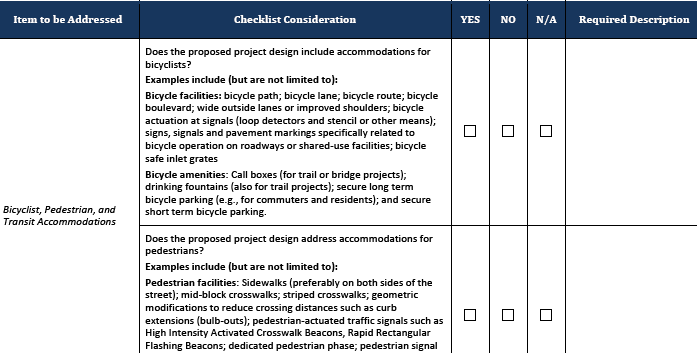As state departments of transportation try to reduce the stubborn problem of pedestrian and cyclist deaths, one tactic they can use is to help local communities adopt complete street policies. In the tri-state region, few are doing as good a job on that front as the New Jersey Department of Transportation. On its complete streets website, NJDOT has published guides not just for how to develop complete streets policies, but also how to come up with a plan to implement them.
Included in both guides is a version of the checklist NJDOT itself uses when it’s developing a project. NJDOT requires that the project manager and designer fill out the checklist “during the earliest stages of the Concept Development or Preliminary Engineering Phase so that any pedestrian or bicycle considerations are included in the project budget.” Among other things, the checklist reminds staff to
- examine existing pedestrian, bicycle and transit infrastructure
- measure existing levels of non-motorized travel and identify missing infrastructure
- coordinate with the local transit agency
- and ensure that projects abide by pedestrian and bicycle design standards.

The value of New Jersey’s complete streets guides goes beyond the checklist, however. The guides also offer advice for local leaders on how to support complete streets beyond just adopting policies. For example, the implementation guide suggests a list of typical plans that may need to be updated after a complete streets policy is passed (master plan, circulation, land use, etc.). It also has examples of how the development review process can support complete streets, and “lessons learned” from towns and cities that have done the work already.
Perhaps most importantly, NJDOT has effectively encouraged local complete streets by offering a funding incentive. Municipalities that have a local complete streets policy and implementation plans receive an extra point (out of 25) when applying for funding from the department’s Local Aid program.
Both New York and Connecticut DOTs have complete streets websites, but so far, neither provides the depth of guidance that New Jersey does. Neither gives funding priority to municipalities with complete streets policies, although Connecticut’s Bike and Pedestrian Advisory Board has recommended that ConnDOT do so. Transportation planners know that complete streets is a team effort, often requiring state and local governments to work together. At least on this front, New Jersey seems to be leading the way in the tri-state region.

[…] Practical Tool For Multi-Modal Planning: Complete Streets Checklist” (https://blog.tstc.org/2014/02/06/steal-this-complete-streets-checklist ) is intended to help planners evaluate specific roadway […]
[…] Practical Tool For Multi-Modal Planning: Complete Streets Checklist” (https://blog.tstc.org/2014/02/06/steal-this-complete-streets-checklist ) is intended to help planners evaluate specific roadway […]